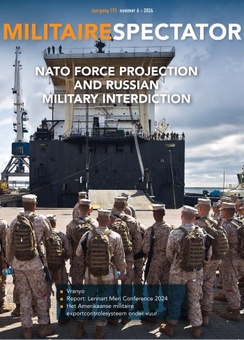Arson in Poland, attempted sabotage of European railway lines, and explosives buried next to NATO fuel pipelines in Germany. This is just a selection of countless so-called hybrid operations that Russia allegedly carries out against Europe. The EU and NATO should not treat these actions as isolated incidents, Estonian Prime Minister Kaja Kallas said at the Lennart Meri Conference (LMC) in Tallinn.[1] The West ‘must connect the dots of Russia’s hybrid activities’ in order to be able to respond decisively. At the same time as the LMC the NATO exercise Spring Storm took place in Estonia.[2]
At the end of May, Poland arrested a number of people associated with sabotage on behalf of Russia. A shopping centre in the capital Warsaw went up in flames, which Prime Minister Donald Tusk said was ‘possibly the work of Russia’.[3] Also in May, the Russian Ministry of Defence published a plan to unilaterally adjust the borders in the Baltic Sea (but later withdrew it) and border markers were stolen in the Narva River (the border between Russia and Estonia). Earlier, in April, Finnair planes were forced to return to Finland because GPS disruptions prevented them from landing in the Estonian city of Tartu. This too was probably the work of Russia. Estonian Foreign Minister Margus Tsahkna spoke of a ‘hybrid attack’ and wants to raise this issue at NATO and the EU.[4]
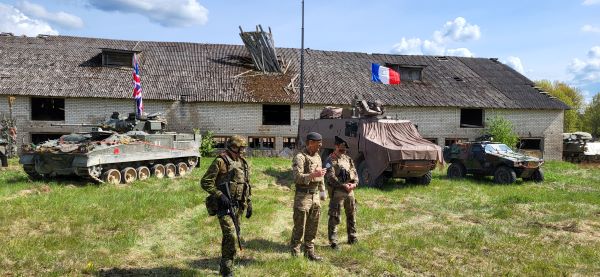
Estonian, British and French officers at a command post in the Spring Storm exercise area. Photo Militaire Spectator
During a session on the sidelines of the LMC, Jonatan Vseviov, Secretary General of the Estonian Ministry of Foreign Affairs, said that the ‘pace and scope of Russian hybrid activities are increasing across Europe’. According to Vseviov they are aimed at undermining Western unity and cohesion and at disrupting military aid to Ukraine. In addition, the hybrid operations seem ‘to compensate for the Russian military being stuck in Ukraine. It is eerily quiet on our border with Russia.’ For now, Estonia itself does not seem to be Moscow’s priority, says Vseviov. ‘We don’t feel particularly vulnerable. The strategic threat Russia poses is significant and existential for us, but we are not afraid. In fact, Estonia is feeling more confident than four years ago, because NATO now moves in the right direction.’
Adapt at a faster pace than Russia
A sign of this ‘right direction’ is the presence of NATO soldiers on Estonian territory. For example, in the context of the Spring Storm exercise, the British 16 Air Assault Brigade Combat Team (the British Army’s ‘Global Response Force’) carried out an airbourne landing ‘to practice the deployment of allied units in Estonia under conditions of military resistance’.[5] Spring Storm is part of the broader NATO exercise Steadfast Defender. In total, 14,000 soldiers from 15 countries participated in the annual exercise, the largest in Estonia. For example, a French company, equipped with the new Jaguar armoured vehicle, practiced tactical training and integration into a British battalion that in turn is part of the NATO battlegroup of the enhanced Forward Presence (the eFP, in Estonia under British leadership as a ‘framework nation’). At a higher level the NATO battlegroup was operating in an integrated manner with the Estonian 1st Brigade. The latter’s commander, Colonel Mart Sirel, warns that the Russian army is not as incapable as some observers sometimes think: ‘The Russians are learning from their experience on the Ukrainian battlefield, and they adapt to it. To stay ahead of them, we must follow suit and adapt at a faster pace.’
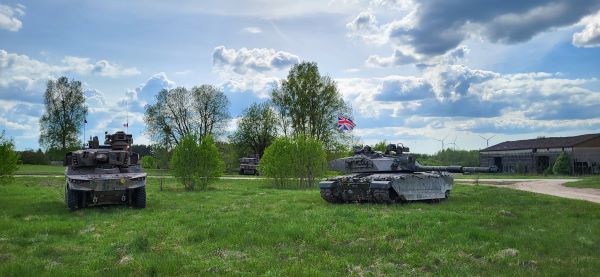
British Challenger tanks and French Jaguar armoured vehicles practiced integrated tactical training. Photo Militaire Spectator
The British practiced, among other things, with Challenger tanks and tested combined operations with the French wheeled armoured vehicle Jaguar. Challenger tanks were delivered to Ukraine last year. One of the lessons of that war, however, is that tanks like the Challenger are too heavy for the muddy soil in parts of Ukraine.
The majority of the soldiers participating in exercise Spring Storm were Estonian: conscripts, reservists, active-duty personnel from the Estonian Defence Forces (EDF) and members of the voluntary national organization Estonian Defence League. At the LMC, former President of Estonia Toomas Hendrik Ilves stated that the country has made great strides by ‘building up its reservists following the Finnish model since independence’. Finland is known for its rapidly scalable armed forces with a sophisticated conscription and reserve system. ‘Proportionally speaking, the Estonian reserve is now larger than that of Finland’, Ilves said.
When asked about the enormous numerical superiority that Russia will have in the event of an invasion, and its willingness to suffer many casualties, Colonel Mait Müürisepp (EDF), Spring Storm’s Exercise Director, noted that numbers alone are not decisive. He points to the importance of democratic values and the role that reservists and Defence League volunteers play in defending them: ‘You have to create a country that is worth fighting for, motivation is key. Next, exercises like this, with reservists participating, are extremely important. In case of an attack, everyone needs to know exactly what to do and how to do it’.
‘Defend our country from the first minute and the first centimetre of our territory’
It is often said that NATO exercises send out a deterrent signal: they show Russia how strong the alliance is, forcing the Kremlin to think twice before launching an attack. Colonel Müürisepp is not so sure that it works like this: ‘Do you really think Moscow will change its behaviour when it observes the exercise we are doing here in Estonia? Of course not. But the more important thing of Spring Storm is that we ourselves are prepared and that we can work together with our allies.’
Being prepared is what it is all about in Estonia. Prime Minister Kaja Kallas, who visited the training troops in the field, pointed out: ‘We have two choices. We can hope the aggressor does not take the next step. Or we prepare to be able to push back the aggressor if he does. We have decided to prepare ourselves as much as we can so we are able to defend our country from the first minute and the first centimetre of our territory’. The major Estonian exercise with NATO allies gives the Prime Minister confidence: ‘NATO now functions the way we thought it would when we were not part of the Alliance’. When the Baltic states joined NATO in 2004 their interests did not always match those of the alliance, because the US was mainly focused on the War on Terror and the administration of George W. Bush sought rapprochement with Vladimir Putin’s Russia.[6] This may have been understandable in the context of the time, but for the Baltic states the Russian threat has never diminished. Jonatan Vseviov sees Putin’s objectives as a constant: he wants ‘to restore the Russian empire and to be a global power’. When the global superpowers discuss the world order the Russian President wants to participate in the conversation because, Vseviov says, ‘Putin thinks that if Russia is not at the table, it is on the menu.’
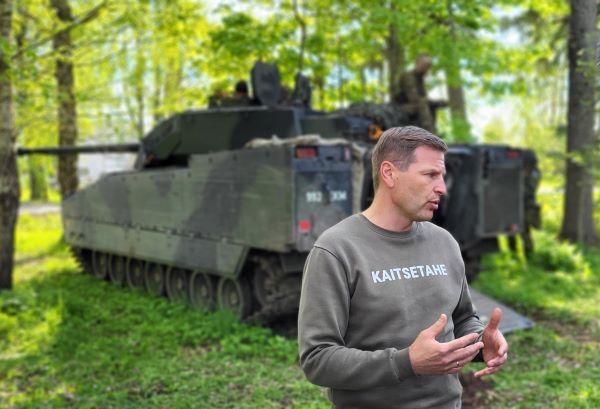
Estonian Minister of Defence Hanno Pevkur addresses the press during exercise Spring Storm 2024. Photo Militaire Spectator
Even though it is quiet on the Estonian-Russian border, per Vseviov, the Baltic states remain a vulnerable part of NATO territory. With the accession of Finland and Sweden to the alliance the Baltic states are easier to defend, and that may be one reason why Moscow is increasing its hybrid operations in the wider Nordic region. Estonian Defence Minister Hanno Pevkur noted that there are still gaps in logistics, A2AD capabilities and control of the Baltic Sea that NATO needs to address. According to him, Russia is still able to rapidly take a piece of Baltic territory before allies can muster reinforcements, and thus create a fait accompli ‘to humiliate NATO’. The Regional Plans that NATO agreed upon at its 2023 Vilnius Summit are a step in the right direction, but they require more funding, says Pevkur.
Back in the field, it is clear Estonia is a front-runner when it comes to the ‘whole-of-society approach’ to defence that more and more NATO officials are advocating. For the first time a civilian component was added to Spring Storm, with role-players practicing an evacuation and citizens receiving warning messages via SMS. From now on, citizens can also act as eyes and ears for the EDF. Shortly before Spring Storm the women’s Defence League organisation Naiskodukaitse launched the ‘Ole Valmis’ app (Be Prepared). This app allows citizens to photograph and report aircraft, helicopters and drones. Using AI, Ole Valmis identifies the flying object, after which the EDF receives the relevant information.[7]
Guided by fear?
Ultimately, wars have a political dimension. Although NATO countries provide a lot of support to Ukraine, some more than others, a clear strategy and end goal are lacking. For now it comes down to perseverance, says Vseviov: ‘Putin goes on because he thinks time is on his side. The many elections on the agenda this year reinforce his beliefs. So that is where the West needs to hit him: keep supporting Ukraine so that early next year the time argument loses credibility in Russia’.
American leadership remains crucial in this regard. However, former US ambassador to NATO Kurt Volker thinks that ‘US policy is guided by fear instead of purpose’, even though Putin ‘is playing a much weaker hand in the war in Ukraine than he lets on’.[8] In the past two years, Moscow repeatedly threatened escalation if the West crossed a red line (supplying more and heavier equipment), but in hindsight the threats were always limited to rhetoric. Another speaker added that this demonstrates that ‘nuclear coercion works, because the White House clearly restrains itself in its aid to Ukraine’. More broadly speaking, this creates a dangerous precedent with regard to the China-Taiwan tensions. According to Volker, caveats for the use of Western weapons on Russian territory should be lifted and there should be no restrictions on the type and quantity of weapons that Ukraine may receive. ‘Russia must feel its own forces on its own soil are vulnerable, that will help Ukraine move forward’, Volker says.
A part of Putin’s time-buying strategy is bringing Russia’s war economy to full speed. One speaker pointed out that a Russian artillery shell costs about $500 to produce, while Western 155mm shells can cost as much as $3-8,000 each. This partly explains the difference in ammunition production between Russia and Western countries. The old adage that quantity is a quality in itself comes into play again here. A speaker pointed to Russia’s artillery advantage: it has ten times the number of guns available compared to Ukraine. In addition, it doesn’t matter that much to the Russians that their equipment is older and less accurate: heavier payloads compensate for the lack of precision, taking out their targets with more powerful explosions. Ukraine may enjoy an advantage in targeting and intelligence, but the Ukrainian armed forces lack the means to exploit their superiority in that area.
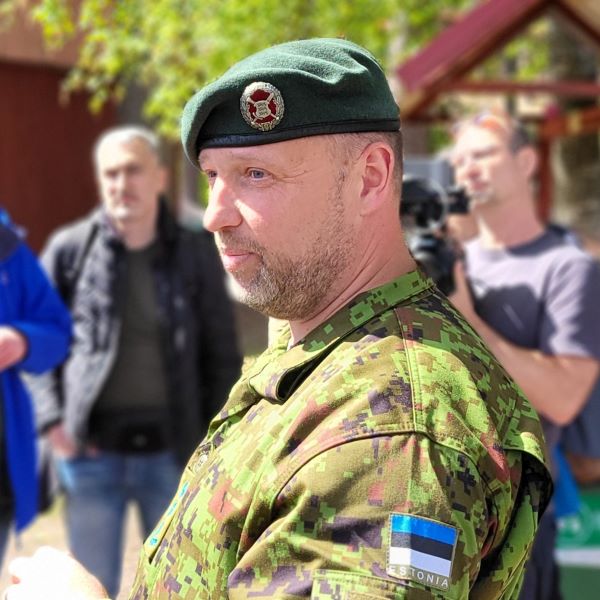
Colonel Mait Müürisepp, Spring Storm’s Exercise Director. Photo Militaire Spectator
At the conference, the question was raised whether Moscow’s hybrid operations are part of a larger campaign. Indeed, some speakers see the war in Ukraine as just a theatre of a broader Russian attack on the West. Former Estonian President Ilves mentions the ‘weaponization of thugs’ by Russia and urges for a stronger NATO response to this phenomenon. Prime Minister Kallas agrees and insists that the West ‘must connect the dots of Russia’s hybrid activities’. These are not isolated incidents, so a coordinated response by NATO is warranted. It is still unclear however what that response should entail because there is currently no consensus among allies about the severity of the incidents and what exactly will breach the Article 5 threshold.
[1]The Lennart Meri Conference was held on 16-18 May. Some of the sessions were subjected to the Chatham House Rule: quotes from those sessions are not attributed to individuals or their affiliations. Prior to the conference, on 15 May, various locations linked to NATO exercise Spring Storm were visited. See: https://lmc.icds.ee/.
[2] NATO, ‘Allied national exercises and activities’. See: https://shape.nato.int/exercises/allied-national-exercises.
[3] ‘Poland arrests sabotage suspects and warns of potential hostile acts by Russia’, ABC News, 21 May, 2024. See: https://abcnews.go.com/International/wireStory/poland-arrests-sabotage-suspects-warns-potential-hostile-acts-110438127.
[4] Tommaso Lecca, ‘Estonia blames Russia for GPS interference that forces Finnair to suspend flights’, Politico, 29 April, 2024. See: https://www.politico.eu/article/estonia-blames-russia-for-gps-interference-that-forces-finnair-to-suspend-flights/.
[5] ‘Gallery: Exercise of Allied airborne troops at Spring Storm’, ERR, 11 May, 2024. See: https://news.err.ee/1609339638/gallery-exercise-of-allied-airborne-troops-at-spring-storm.
[6] Jeroen Bult, ‘20 jaar na de Baltische toetreding tot de NAVO’, Atlantisch Perspectief 48 (2024) (2). See: https://www.atlcom.nl/artikelen-atlantisch-voorwaarden/20-jaar-na-de-baltische-toevoering-tot-de-navo/.
[7] ‘Large-scale military exercise Spring Storm starts on Monday’, ERR, 3 May, 2024. See: https://news.err.ee/1609331355/large-scale-military-exercise-spring-storm-starts-on-monday.
[8] ‘US ex-representative to Ukraine: Russia playing a weaker hand than it might seem’, ERR, 17 May, 2024. See: https://news.err.ee/1609345059/us-ex-representative-to-ukraine-russia-playing-a-weaker-hand-than-it-might-seem.
